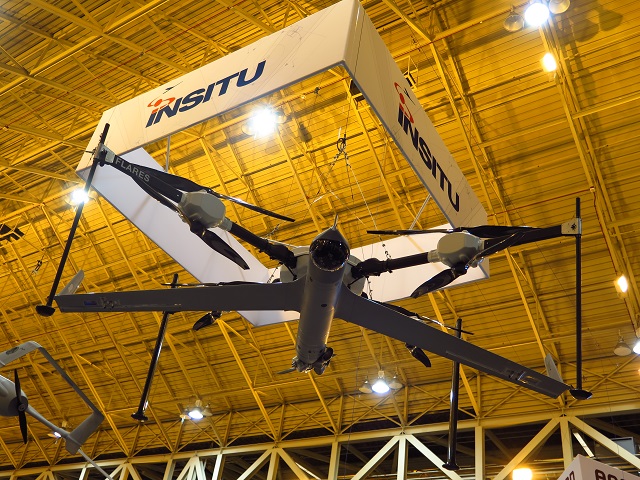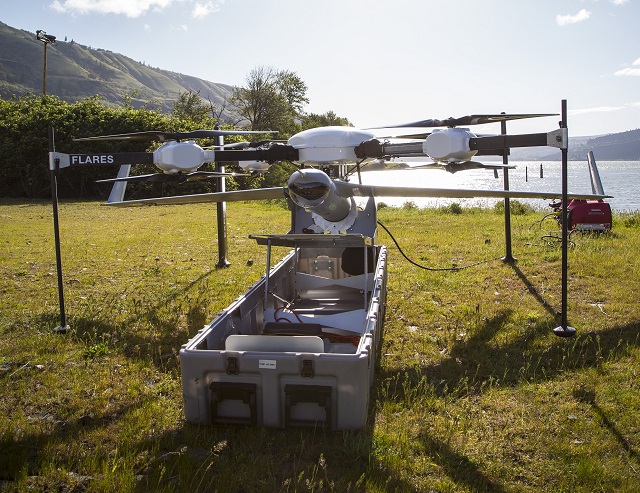 The quadcopter-based contraption Insitu and Hood Technology have developed for launching the ScanEagle – the flying launch and recovery system (FLARES) – should be ready for production by late 2017.
The quadcopter-based contraption Insitu and Hood Technology have developed for launching the ScanEagle – the flying launch and recovery system (FLARES) – should be ready for production by late 2017.
Insitu’s director of advanced development, Andrew Hayes, told Flightglobal at the AUVSI Xponential exhibition in New Orleans, Louisiana on 3 May, the four-legged, eight-rotor FLARES launching system has attracted a “tremendous” amount of interest. A baseline prototype should be ready later in the year for further developmental testing, and the production-ready variant is expected in late 2017.
With a wingspan of 3m (10ft) and maximum gross take-off weight of 22kg (49lb), the ScanEagle is normally launched from Insitu’s trailer-mounted Mark 4 catapult launcher and recovered via the SkyHook system, which uses differential GPS navigation to guide the aircraft into a trapping cable.
That equipment can be cumbersome and is not always suitable for launching UAVs from inside walled military bases, jungle canopies or an unimproved field.
“The FLARES unit starts autonomously, flies up to its release altitude, flies forward to a certain speed and releases the ScanEagle so that it autonomously takes off and goes into an orbit,” Hayes explains. “The FLARES unit returns back to where it took off and hovers waiting for the operator to give the all-clear.”
As the ScanEagle returns from its orbit, a trapping cable is hoisted up and kept tight by the quadcopter, and the ScanEagle catches it with a hooking mechanism on the leading edge of its wings.
The industry-funded initiative is aimed at launching the ScanEagle initially, but Hayes thinks there is the potential to launch other small unmanned aircraft systems (SUAS) the same way. This system, he says, gives aerodynamically-efficient fixed-wing SUAS a vertical take-off capability without design tradeoffs.
Insitu will offer it to military and commercial ScanEagle customers. The first proof-of-concept flight took place in December 2014 and was followed by a captive-carry demonstration in July. The first full launch and recovery demonstration followed in August.
ScanEagles have been supporting combat operations since the type’s first deployment to Iraq, in 2004 with the US Marine Corps. Since then it has racked up more than 885,000 combat flight hours.
A typical ScanEagle setup requires multiple trucks to carrying the launcher, catcher, and ground control station equipment. The goal with FLARES is to shrink that logistical footprint down to six or eight cases for two air vehicles, two launch systems, the control terminal, and spare parts.
Hayes notes the main emphasis at the moment is on land-based operations, although Insitu is exploring maritime applications for FLARES on navy surface vessels.
Along with a smaller footprint, the FLARES concept could also greatly reduce airframe and component fatigue by reducing the g-loading relative to the catapult system.
“You don’t have to accelerate a vehicle from full-stop to flight speed in a short amount of time,” he says. “That tends to be our highest g-loading. It just shortens the life of the equipment.”
Source: Flightglobal

